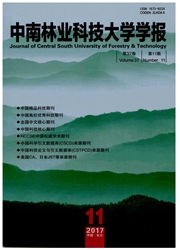

 中文摘要:
中文摘要:
2008年1~2月严重的冰雪灾害袭击了广东粤北地区,导致杉木林产生大量的折干残体,增加林地的碳和养分输入。折干残体中的难分解物质直接影响生态系统的碳和养分循环,然而还不了解冰雪灾害后杉木林折干残体的储量和养分动态规律。分析了粤北冰雪灾害后的杉木林折干残体的储量和养分动态,结果表明:从2008年到2011年,折干残体的质量从6.86t·hm-2减少到6.11t·hm-2,N含量从1.99g·kg-1增加到2.33g·kg-1,P含量从0.19g·kg-1增加0.23g·kg-1,而K含量从0.88g·kg-1。下降到0.75g·kg-1。折干残体N累积量从13.65kg·hm-2增加到14.22k·hm-2,P累积量从1.30k·hm-2增加到1.40kg·hm-2,而K累积量从6.04kg·hm-2减少到4.58kg·hm-2。折干残体缓慢的分解特点对于碳的储存有重要作用。
 英文摘要:
英文摘要:
The severe ice storms that occurred in early 2008 in northern Guangdong province, China, resulted in a lot of stem debris in a Cunninghamia lanceolata stand. Due to its recalcitrant chemical composition and slow decomposition, stem debris can have direct effects on ecosystem carbon and nutrient turnover. However, stem debris dynamics of mass and nutrients have not yet been well-understood. This study analyzed the impacts of the early 2008 ice storm on stem debris dynamics of mass and nutrients in a Cunninghamia lanceolata stand. From 2008 to 2011 stem debris mass decreased gradually, ranging from 6.86 to 6.11 t.hm-2, N and P contents increased gradually, ranging from 1.99 to 2.33 and 0.19 to 0.23 g.kg-1, respectively, whereas K content decreased gradually, ranging from 0.88 to 0.75 g.kg-1. N and P accumulation of stem debris increased gradually, ranging from 13.65 to 14.22 and 1.30 to 1.40 kg.hm-2, respectively, whereas K accumulation of stem debris decreased gradually, ranging from 6.04 to 4.58 kg.hm-2. This is the first quantitative determination of the effects of ice storms on stem debris in Cunninghamia lanceolata stands. The long term storage of C and slow rate of decomposition of stem debris make it become a major controller of forest ecosystem C-retention.
 同期刊论文项目
同期刊论文项目
 同项目期刊论文
同项目期刊论文
 期刊信息
期刊信息
